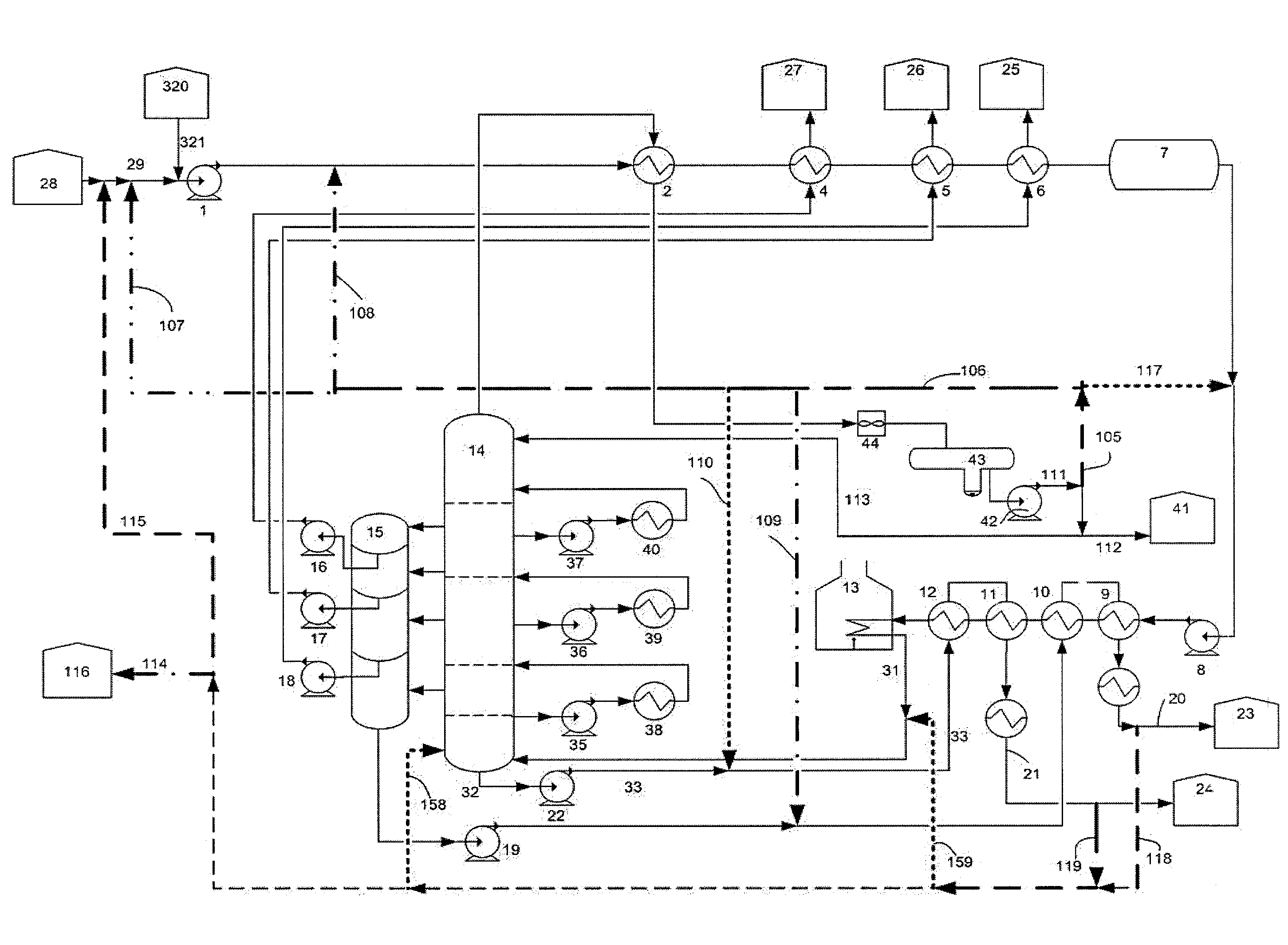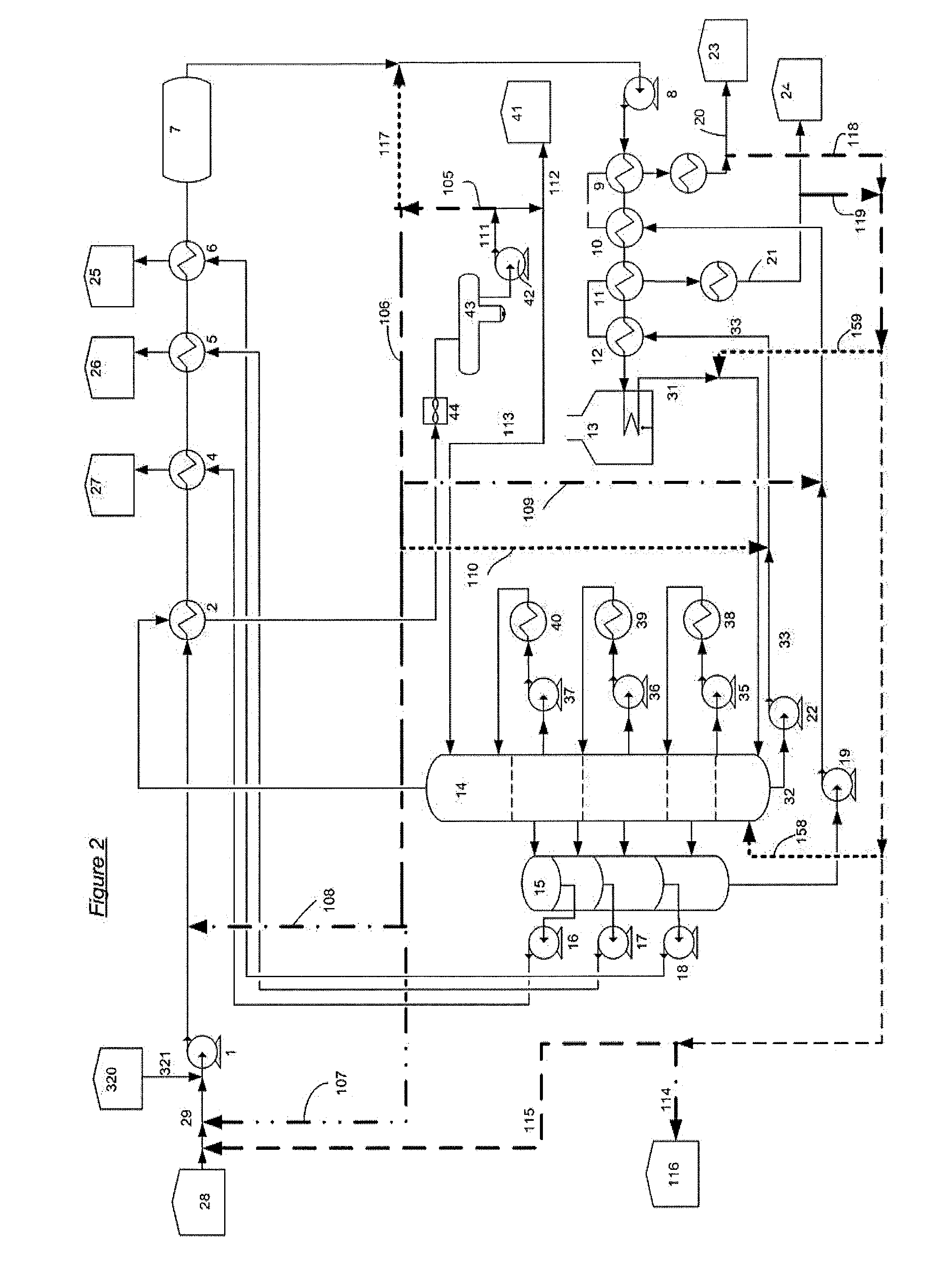Method, apparatus and chemical products for treating petroleum equipment
a petroleum equipment and chemical technology, applied in hydrocarbon distillation, liquid carbonaceous fuels, heating types, etc., can solve problems such as equipment fouling, coke and coke-like deposits, and plant fouling
- Summary
- Abstract
- Description
- Claims
- Application Information
AI Technical Summary
Benefits of technology
Problems solved by technology
Method used
Image
Examples
example n.1
[0329]A crude atmospheric distillation plant (CDU) has a design throughput of 500 tons per hour (T / h) and a technical minimum throughput of 250 T / h. Based on design throughput there have also been designed downstream plants, which receive the products resulting from distillation as well as distillation residue. The distillation yield of the typical processed crude is: 20% gasoline, 20% kerosene, 30% gas oil, 30% atmospheric residue. At the design throughput this corresponds to 100 T / h gasoline, 100 T / h kerosene, 150 T / h gas oil, 150 T / h atmospheric residue. When the fresh feed rate is 250 T / h, a yield of 50 T / h gasoline, 50 T / h kerosene, 75 T / h gas oil, 75 T / h atmospheric residue will be achieved. The plant is however designed to manage a production up to 150 T / h gas oil and a feed of 500 T / h, therefore it is possible to introduce in the plant, in one or more points (e.g., in the feed), up to 75 T / h gas oil (e.g., coming from storage). In this latter case therefore, the feed will be...
example n.2
[0330]The crude atmospheric distillation plant (CDU) of example 1 runs at a fresh feed flowrate of 400 T / h, therefore the production will be 80 T / h gasoline, 80 T / h kerosene, 120 T / h gas oil, 120 T / h atmospheric residue. The fresh feed rate is then increased to 500 T / h, and the “exceeding” 30 T / h gas oil will be re-introduced and circulated in the plant. The fresh feed rate is then decreased back to 400 T / h and the gas oil “exceeding” the one of normal production will be re-introduced and circulated in the plant. The plant can thereafter continue to run under these conditions (fresh feed 400 T / h, circulating self-produced gas oil 30 T / h) or by reducing, e.g., the fresh feed to 300 T / h, by having 60 T / h of “exceeding” gas oil re-introduced and circulated in the plant. The fresh feed can then be reduced to 250 T / h, thereby distilling 150 T / h gas oil. From the distilled 150 T / h gas oil, e.g., 75 T / h will exit the plant to satisfy production needs, while 75 T / h will be re-introduced in ...
example n.3
[0333]With reference to FIG. 12, during the normal run, two feed pumps (401) and (403) are running, while the pump (402) is idle and in stand-by as a spare of (401) and (403. The same applies to the booster pump (500), a spare of (501) and (502), which during the normal run will have the valves (516) and (517) closed. Moreover, all of the cold train exchangers (from 404 to 408 and from 503 to 507), the desalters (409 and 508) and all of the hot train exchangers (from 410 to 416 and from 509 to 515), are inserted in the production cycle (valves 427, 428, 518, 520, 437, 438, 529, 530 opened). Hereinafter are exemplary described the operations, under the present invention, to clean one hot preheat line, while the other preheat line is inserted in the production cycle and allows for the run of the plant. In order to realize the present invention, e.g., to clean one hot preheat line, firstly the valves (518), (520) are closed to isolate the equipment to be cleaned; the valves (516) and (...
PUM
| Property | Measurement | Unit |
|---|---|---|
| Temperature | aaaaa | aaaaa |
| Temperature | aaaaa | aaaaa |
| Temperature | aaaaa | aaaaa |
Abstract
Description
Claims
Application Information
 Login to View More
Login to View More - R&D
- Intellectual Property
- Life Sciences
- Materials
- Tech Scout
- Unparalleled Data Quality
- Higher Quality Content
- 60% Fewer Hallucinations
Browse by: Latest US Patents, China's latest patents, Technical Efficacy Thesaurus, Application Domain, Technology Topic, Popular Technical Reports.
© 2025 PatSnap. All rights reserved.Legal|Privacy policy|Modern Slavery Act Transparency Statement|Sitemap|About US| Contact US: help@patsnap.com



